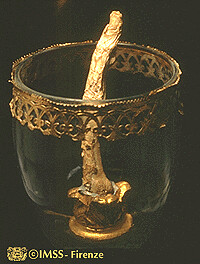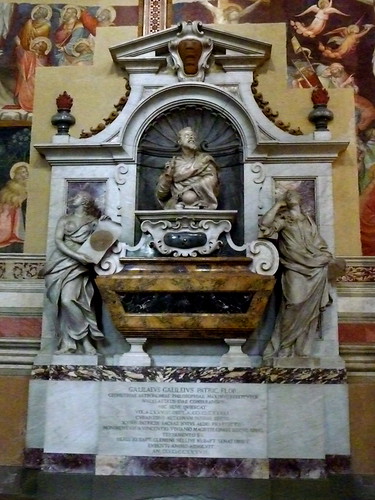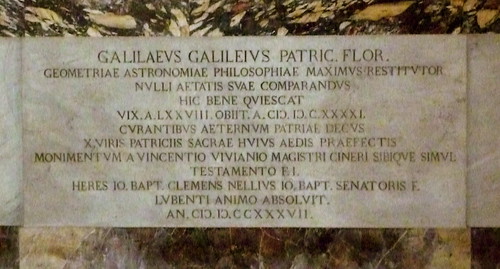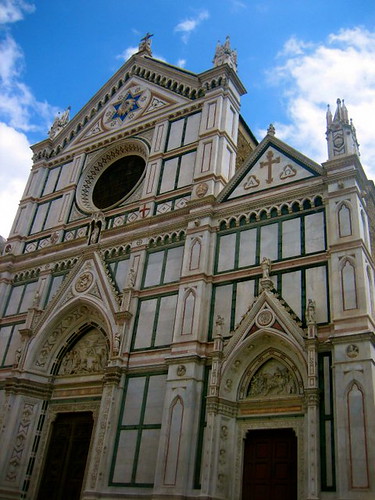If you only see one petrified middle finger in your life…
- By Faith Tucker
- July 28, 2010
- 3 Comments
To be honest, I’ve never really understood why people go to crazy lengths to get the autographs of celebrities. It’s just their name in squiggly, illegible handwriting, after all – not worth hours waiting in line, if you ask me. But you know what would be an exciting way to interact with famous people, especially those long since deceased? Go check out their petrified middle finger! Ok, maybe that isn’t the most widely available option, but you Galileo fans out there are in luck. Make your way to Florence, Italy, and you will find nothing short of a Galileo Disneyland, including his tomb, an entire museum devoted to him and, you guessed it, his middle finger!

Galileo’s middle finger preserved and on display
Photo Credit: Instituto e Museo di Storia della Scienza and NASA Jet Propulsion Lab
Perched along the Arno River and just around the corner from the magnificent Uffizi Gallery is the Museo Galileo: Instituto e Museo di Storia della Scienza (Galileo Museum: Institute and Museum of the History of Science). The museum houses the only remaining instruments designed and built by Galileo himself and the extensive collections of the Medici family and the House of Lorraine, the two dynasties that once ruled Florence, which represent the scientific landscape from which Galileo emerged and his ensuing effect on modern science, respectively.
St. Croce Basilica
Photo Credit: Amanda Westwood
 The St. Croce Basilica stands out from a bird’s eye view of Florence
The St. Croce Basilica stands out from a bird’s eye view of Florence
Photo Credit: Shannon Hall
According to its website, the museum may “display more than 1,000 instruments and devises of major scientific importance and exceptional beauty,” but let’s be serious, you’re going to make a beeline straight to the disembodied finger. The somewhat shriveled, spindly finger contrasts oddly with its ornate Easter egg-like pedestal, making the whole scene that much more surreal. As exciting as it may be to see the finger that adjusted that legendary objective lens to bring into focus so many wonders of our solar system for the very first time, you can’t deny that it’s just a little bit odd.
Galileo died in 1642, but the middle finder of his right hand remaining intact until 1737 when his body was relocated to its current resting place in the Basilica St. Croce by the last of the Medici Grand Dukes. His new tomb, which is conveniently located within walking distance of the Museo Galileo, boasts an impressive and extravagant mausoleum and shares the space with the tomb of Michelanglo.

Galileo’s tomb in the St. Croce Basilica
Photo Credit: Shannon Hall
Contrary to public belief, Galileo neither invented the telescope nor was he excommunicated by the Catholic Church because of what he saw through it, but his life was certainly exciting and makes for a fascinating study in the philosophy of science and the intersection of science and religion.
In 1609, Galileo heard of a Dutch lensmaker named Hans Lippershey who had developed an instrument that could magnify distant objects up to 3 times with two lenses. He immediately began experimenting with lenses and within months had improved the magnification to 20 times. With his new instrument, dubbed a telescope, Galileo observed for the first time the rocky, mountainous surface of the moon, sunspots on the sun’s surface, the phases of Venus and four of Jupiter’s moons, among other things. All of these discoveries contributed to and solidified Galileo’s suspicions that the Aristotilean understanding of the universe was not as accurate as the scientific world had long believed and that Copernicus and his heliocentric theory may not be so far off base after all.
However, Galileo’s new evidence did not mesh well with the Catholic Church’s interpretation of scripture at the time and so prompted prolonged discussion and disagreement between the two parties. Galileo wrote many books and pamphlets to defend Copernicanism, one of which was a treatise on what he thought the relationship between religion and science ought to be, written as an open letter entitled Letter to The Grand Duchess Christina.
Many rather conflicting accounts exist as to how this disagreement between Galileo and the Catholic Church actually played out. After reading a variety of different accounts, it seems to me that the Catholic Church in general was not particularly concerned with the scientific community’s views of the universe and was more than happy to accept Copernicanism as a valid theory. But Galileo was determined to press the issue, thereby putting the Church in the difficult position of either wholeheartedly supporting an as yet unproven theory that conflicted with their interpretation of scripture or declaring it heretical. In the end, Galileo pushed so hard that he was called to the Inquisition where he was given a firm slap on the wrist for meddling in theology as a layman and was put under house arrest for the rest of his life in Florence’s countryside.

The inscription on Galileo’s tomb
Photo Credit: Shannon Hall
Regardless of the cultural context in which his work appeared, Galileo’s life and work have certainly had an enormous effect on our knowledge of the universe, how we physically view the universe and how our understanding of the universe informs other aspects of our lives. And what have we done in honor of his foundational work? We have immortalized his finger. Perhaps it’s a bit odd, but no one ever said astronomers were exactly normal…
I’ll leave you with a quote of Galileo’s in which he urges the scientific world to transition from seeing science simply as philosophy to seeing it as a mathematical and physical description of the world, as well as the link to a Swiss cartoonist who has represented Galileo’s life (and many other famous scientists’ lives) like no one else ever has:
“Philosophy is written in this grand book, the universe, which stands continually open to our gaze. But the book cannot be understood unless one first learns to comprehend the language and read the letters in which it is composed. It is written in the language of mathematics, and its characters are triangles, circles, and other geometric figures without which it is humanly impossible to understand a single word of it.”
~ Il saggiatore (The Assayer), published in 1623
And don’t forget, if you only see one petrified middle finger in your life, make sure it’s Galileo’s!





Love that quote! Great blog! :-)
[…] If you want to learn about Galileo, or even meet part of him, then there’s a museum in Florence where you can do just that – it is reviewed by NASA’s Blueshift Blog in this post. […]
Wonderful writing, Faith, as always! Your blogging voice is spot-on. Keep it up.